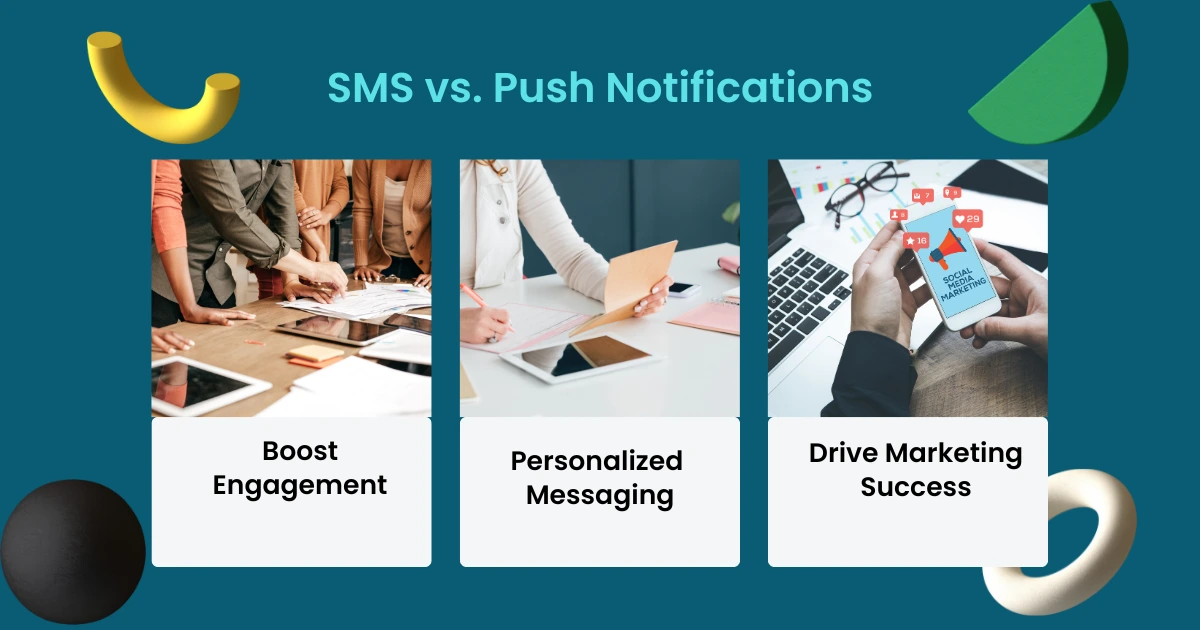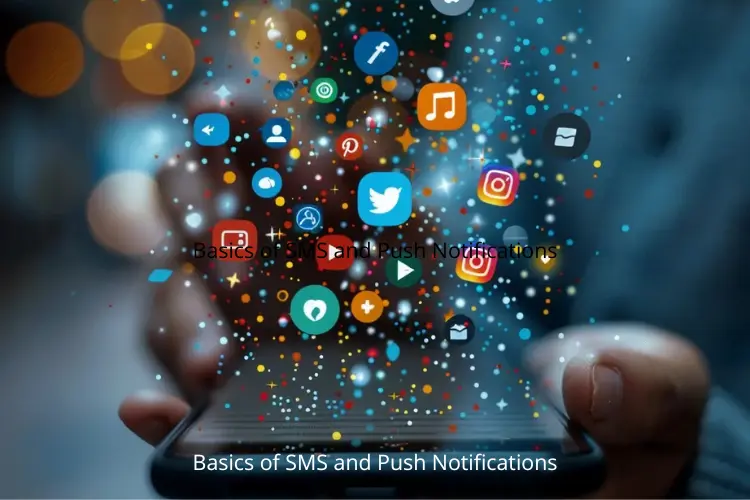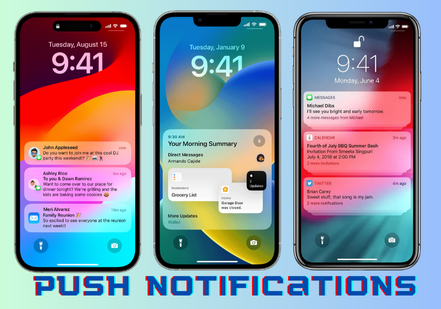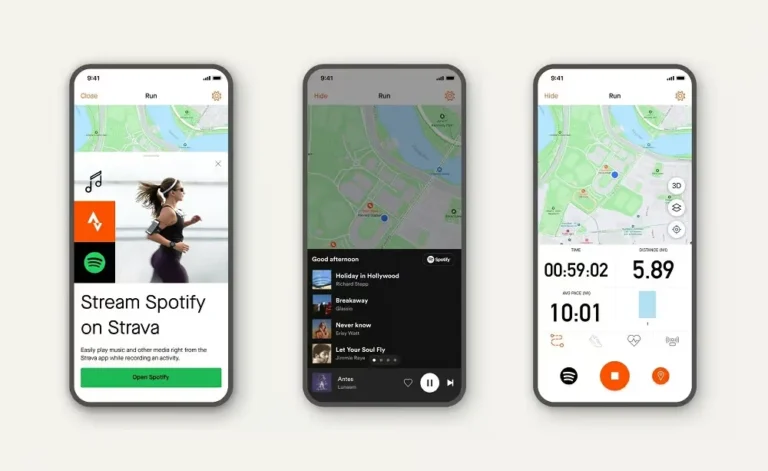SMS vs Push Notifications: Proven Strategies to Achieve Outstanding Mobile Marketing Results

Did you know that SMS messages boast a staggering 90% open rate within the first three minutes of delivery? Similarly, push notifications, when crafted effectively, can boost app engagement rates by up to 88%. In today’s mobile-first world, businesses are increasingly asking, “SMS vs. Push Notifications: which is more effective for mobile marketing?”
These two tools are game-changers for delivering timely, personalized, and impactful messages straight to users’ devices. Whether you’re reminding a customer of an upcoming appointment, announcing a flash sale, or re-engaging app users who’ve gone silent, understanding the strengths and differences of SMS vs. Push Notifications can redefine your mobile marketing strategy and help you stay ahead in a highly competitive landscape.
This article explores the role of SMS and push notifications in mobile marketing, their key differences, and best practices, giving you actionable insights to drive engagement and deliver meaningful results.
Table of Contents
1. What Are SMS vs Push Notifications?
SMS is a text messaging service that allows businesses to send messages to mobile phones. These messages are delivered directly to a user’s SMS inbox and can include promotions, appointment reminders, order confirmations, or alerts. SMS is simple, universally accessible, and doesn’t require an internet connection, making it a highly reliable communication channel.
Push notifications, on the other hand, are short messages sent from an app directly to a user’s device. They are typically delivered when a user has downloaded an app and opted-in to receive notifications. Push notifications appear as pop-up alerts on the user’s home screen, even when the app isn’t in use. They can be used to share updates, reminders, or personalized messages.
2. Key Differences Between SMS and Push Notifications

Both SMS and push notifications are powerful tools for mobile marketing, but they serve different purposes and excel in different scenarios. Understanding their key differences can help businesses decide when and how to use each channel effectively. Below, we dive deeper into their unique characteristics, supported by real-world examples, and highlight potential limitations to provide a balanced view.
Delivery
- SMS: Messages are sent through mobile networks and do not require an app. SMS is universally accessible, reaching all mobile users regardless of the device they use.
- Example: A retail store uses SMS to send order confirmation messages and delivery updates. This ensures customers receive important information immediately, even if they do not have internet access.
- Limitation: SMS relies on users providing their phone numbers, which some customers may be hesitant to share due to privacy concerns.
- Push Notifications: These messages are sent via apps and require users to download the app and opt-in to notifications. They appear as pop-up alerts on the device, even when the app is not actively in use.
- Example: A food delivery app like DoorDash sends push notifications to inform users about exclusive discounts or updates on their delivery status.
- Limitation: Push notifications are limited to users who have installed the app and enabled notifications, which may reduce the reach compared to SMS.
Reach
- SMS: Universally accessible on any mobile phone, making it a reliable communication channel for reaching broad audiences.
- Case Study: During the COVID-19 pandemic, governments and healthcare organizations used SMS to send critical updates and appointment reminders for vaccination campaigns.
- Limitation: SMS can be perceived as intrusive if not used sparingly and with relevant content.
- Push Notifications: Effective for engaging app users who have already shown interest in your brand by downloading the app.
- Case Study: E-commerce platforms like Amazon use push notifications to remind users of items left in their shopping carts or to announce flash sales.
- Limitation: Notifications can be ignored or dismissed, especially if they are too frequent or irrelevant, leading to potential app uninstalls.
Opt-In Requirements
- SMS: Requires explicit consent from users, often obtained through sign-up forms or during account creation.
- Example: A fitness studio asks members to opt-in for SMS notifications to receive reminders for class schedules or special promotions.
- Limitation: Obtaining consent can be a hurdle if users are wary of spam or privacy concerns.
- Push Notifications: Requires users to opt-in through their device or app settings, making it a more voluntary form of communication.
- Example: A news app like BBC prompts users to enable push notifications to receive breaking news alerts.
- Limitation: If users do not opt-in or disable notifications, the business loses a critical channel for engagement.
Customization and Media
- SMS: Limited to text and short links, though rich media is possible through MMS (Multimedia Messaging Service), which can incur higher costs.
- Example: A car dealership uses SMS to send personalized messages like, “Hi [Name], your scheduled car maintenance is due. Click here to book your appointment.”
- Limitation: The lack of visual appeal and interactivity can make SMS less engaging compared to push notifications.
- Push Notifications: Can include rich media such as images, emojis, videos, and interactive buttons, making them more visually engaging and actionable.
- Example: Spotify uses push notifications with personalized playlists and album covers to encourage users to explore new music.
- Limitation: Overly designed or flashy notifications can sometimes overwhelm users and detract from the core message.
Cost
- SMS: Typically incurs a cost per message sent, which can add up for businesses running large-scale campaigns.
- Example: A real estate agency sending SMS reminders for property viewing appointments may find the cost justified due to the high value of each lead.
- Limitation: The cost per message makes SMS less suitable for frequent or low-priority communications.
- Push Notifications: Free to send once the app is developed, making them a cost-effective option for large-scale engagement.
- Example: A gaming app sends daily rewards notifications to encourage app usage, leveraging the cost-free nature of push notifications.
- Limitation: While sending notifications is free, the initial app development and maintenance can be costly.
Engagement and Effectiveness
- SMS: Boasts high open rates, with most messages read within minutes, making it ideal for urgent and time-sensitive communication.
- Example: A travel agency uses SMS to notify customers about flight delays or gate changes, ensuring they receive critical updates instantly.
- Limitation: SMS lacks the ability to track in-depth engagement metrics like clicks or interactions.
- Push Notifications: Encourages interaction through dynamic content and actionable elements.
- Example: A fitness app sends motivational push notifications with progress updates, prompting users to complete their daily workout goals.
- Limitation: Overuse or irrelevant content can lead to “notification fatigue,” causing users to disable notifications or uninstall the app.
Final Thought on Limitations
While SMS offers reliability and universal reach, its costs and limited media capabilities may restrict its use to essential or high-impact messages. Conversely, push notifications are dynamic and cost-effective but are limited to app users and require careful planning to avoid overloading users with unnecessary alerts.
By considering these differences, businesses can strategically integrate both tools into their mobile marketing campaigns to maximize engagement and achieve their goals.
Table 1: The comparison between SMS and Push Notifications
| Aspect | SMS | Push Notifications |
|---|---|---|
| Delivery | Sent via mobile networks; no app required. | Sent via apps; requires app download and user opt-in. |
| Reach | Universally accessible on all mobile phones. | Limited to users who have downloaded the app and opted-in for notifications. |
| Opt-In Requirements | Requires user consent via sign-up or subscription. | Requires opt-in through app settings. |
| Customization & Media | Limited to text (can include links); rich media possible with MMS but at a higher cost. | Supports rich media (images, emojis, videos, action buttons). |
| Cost | Typically incurs cost per message. | Free to send (after app development costs). |
| Engagement | High open rates (90%+); ideal for urgent and time-sensitive messages. | Interactive and visually engaging; suitable for user re-engagement and personalized content. |
| Effectiveness | Reliable for critical updates like appointment reminders or delivery notifications. | Encourages real-time interaction with features like interactive buttons and personalized notifications. |
| Examples | Order confirmations, appointment reminders, flash sale announcements. | Cart abandonment reminders, breaking news alerts, in-app promotions. |
| Limitations | Costs can add up for large campaigns; lacks interactivity. | Limited to app users; overuse may lead to “notification fatigue” or app uninstalls. |
3. Benefits of SMS in Mobile Marketing
High Open Rates:
SMS messages boast one of the highest open rates, with over 90% of messages read within three minutes. This makes SMS an effective way to ensure your message is seen by recipients.
- Example: A restaurant could use SMS to remind customers of their reservations, ensuring fewer no-shows and maximizing table utilization.
Immediate Delivery:
SMS is an instant communication tool, making it ideal for time-sensitive messages like appointment reminders or flash sales.
- Example: An e-commerce store can notify customers about a one-hour flash sale via SMS, driving immediate traffic to their site.
Wide Accessibility:
SMS works on all mobile phones, including basic feature phones, and doesn’t require an internet connection. This makes it a universal communication channel.
- Example: A healthcare provider could use SMS to remind patients in rural areas about upcoming check-ups, regardless of internet access.
Personalization:
Businesses can personalize SMS messages by addressing recipients by name and sending offers based on their preferences or past behavior.
- Example: A clothing retailer could send a personalized message such as, “Hi Sarah, get 20% off on your favorite dresses this weekend!”
High Engagement:
SMS encourages immediate responses, especially for two-way communication like surveys or customer support.
- Example: A utility company can use SMS to gather feedback on service quality, providing a direct and simple way for customers to engage.
4. Benefits of Push Notifications in Mobile Marketing
Engagement with Active Users:
Push notifications target users who have already downloaded your app, making them effective for engaging a pre-existing audience.
- Example: A fitness app could send daily motivational messages to encourage users to stick to their workout goals.
Rich Media and Interactivity:
Push notifications can include images, emojis, videos, and interactive buttons, enhancing the user experience.
- Example: A food delivery app might send a push notification with a pizza emoji and a “Reorder Now” button, streamlining the order process.
Personalized Messages:
Notifications can be tailored based on user behavior within the app.
- Example: An online retailer might notify a user who abandoned their cart, saying, “Don’t miss out on your favorite sneakers—only a few left in stock!”
Real-Time Updates:
Push notifications deliver real-time information, perfect for urgent updates or alerts.
- Example: A news app can send breaking news alerts directly to users’ devices, keeping them informed and engaged with the platform.
Cost-Effective:
Once your app is developed, push notifications are free to send, making them a scalable and budget-friendly communication method.
- Example: A gaming app can use push notifications to inform users about daily rewards or new levels, increasing app engagement without additional costs.
5. Best Practices for SMS and Push Notifications

To maximize the effectiveness of SMS and push notifications in your mobile marketing strategy, follow these best practices to engage your audience while ensuring compliance with legal requirements and ethical standards.
Get Explicit Opt-Ins
Before sending any SMS or push notification, ensure that users have explicitly opted in to receive them. This builds trust and helps maintain compliance with data privacy laws like GDPR (General Data Protection Regulation) in Europe and CCPA (California Consumer Privacy Act) in the US.
- For SMS: Use clear language in your sign-up forms, such as, “By providing your phone number, you agree to receive promotional messages from [Your Company].”
- For Push Notifications: Prompt users with an opt-in message within your app, explaining the value they’ll receive, such as real-time updates or exclusive offers. For example, “Stay informed! Enable push notifications to get instant updates on discounts and new arrivals.”
Keep It Short and Focused
Both SMS and push notifications have limited space, so make every word count. Deliver clear, concise messages with a strong Call-to-Action (CTA) to guide users toward the desired action.
- Example for SMS: “Your 15% discount code is here! Use SAVE15 at checkout. Hurry—expires in 24 hours! [Link]”
- Example for Push Notifications: “Your favorite items are back in stock! Tap here to shop now.”
Personalize Your Messages
Personalization can significantly boost engagement. Address users by name, use location-based targeting, or reference past behaviors to make messages more relevant.
- For SMS: “Hi Alex, enjoy free shipping on your next order! Click here to claim: [Link].”
- For Push Notifications: “Hi Maria, we noticed you left a pair of boots in your cart. They’re selling fast—grab them before they’re gone!”
Use Time-Sensitive Offers
Both SMS and push notifications are excellent for promoting time-sensitive offers, as they create a sense of urgency.
- Example for SMS: “Flash Sale! 30% off everything for the next 2 hours only. Shop now: [Link].”
- Example for Push Notifications: “Hurry! Your 50% discount on premium membership expires in 30 minutes.”
Segment Your Audience
Segmenting your audience ensures your messages are relevant and targeted, leading to higher engagement.
- For SMS: Group users by demographics, purchase history, or preferences. For instance, send a discount code for winter clothing only to users in colder regions.
- For Push Notifications: Use behavioral data, such as app activity, to segment users. For example, send a re-engagement notification to users who haven’t opened the app in 30 days.
A/B Test Your Messages
Experimenting with different message formats, timing, and content can help you optimize engagement rates.
- For SMS:
- Test message length: Shorter messages (e.g., “Get 20% off now: [Link]”) vs. slightly longer, detailed ones.
- Compare CTAs: “Claim Discount” vs. “Shop Now” or “Redeem Offer.”
- For Push Notifications:
- Test notifications with and without rich media, such as images or emojis.
- Compare timing, such as sending a notification in the morning vs. the evening.
- Experiment with urgency levels, like “Limited stock!” vs. “Just arrived!”
Be Mindful of Timing
Timing is everything. Deliver messages when users are most likely to engage to avoid irritation or unsubscriptions.
- For SMS: Send messages during business hours or align with your audience’s time zone. Avoid sending messages early in the morning or late at night.
- For Push Notifications: Use behavioral data to determine the best times. For example, if a user frequently uses your app in the evenings, schedule notifications accordingly.
Monitor and Analyze Performance
Track key metrics to evaluate the success of your campaigns and refine your strategy.
- For SMS: Measure open rates, click-through rates (CTR), and response rates. For example, track how many users clicked the link in your SMS to access a promotion.
- For Push Notifications: Monitor metrics like open rates, app engagement post-notification, and conversion rates to determine the effectiveness of your messages.
Avoid Overloading Users
Too many messages can overwhelm users, leading to notification fatigue or even unsubscriptions. Stick to a balanced frequency and only send messages when they offer real value.
- Example: Limit SMS to 1-2 messages per week for promotional purposes and use push notifications sparingly for urgent or highly relevant updates.
Ensure Regulatory Compliance
Stay informed about and comply with all relevant regulations, such as GDPR, CCPA, and TCPA (Telephone Consumer Protection Act). This includes maintaining opt-in records, providing users with clear opt-out options, and respecting their preferences.
- Example for SMS: Include an opt-out option like, “Reply STOP to unsubscribe.”
- Example for Push Notifications: Provide clear instructions within the app settings on how users can disable notifications.
By following these best practices, you can maximize the effectiveness of SMS and push notifications, ensuring a positive experience for your audience while maintaining compliance and building trust.
6. When to Use SMS and Push Notifications
SMS and push notifications are versatile tools that cater to different communication needs. Choosing the right tool depends on your goals, audience, and message type. Below is a detailed guide, enriched with examples and a decision matrix, to help businesses decide which channel to use and explore how they can complement each other.
Decision Matrix: Choosing Between SMS and Push Notifications
| Goal | Best Channel | Example |
|---|---|---|
| Urgent or time-sensitive messages | SMS | “Your doctor’s appointment is confirmed for tomorrow at 10:00 AM.” |
| Reaching users without an app | SMS | “Your package will arrive today. Track it here: [Link]” |
| Promoting app features or updates | Push Notifications | “New feature alert! Customize your dashboard now with our latest update.” |
| Personalized content for app users | Push Notifications | “Hi Sarah, the boots you liked are now 20% off! Tap to shop.” |
| Limited-time offers | Both (based on audience reach) | SMS: “Flash Sale: 50% off for the next 2 hours! [Link]” Push: “Hurry! Your discount expires soon.” |
| Encouraging customer feedback | Both (complementary) | SMS: “Your delivery is complete! Rate your experience: [Link]” Push: “Leave a review and get 10% off your next order!” |
| Targeting inactive app users | Push Notifications | “We miss you! Tap to see what’s new in our app.” |
| Broad notifications or alerts | SMS | “Severe weather alert: Stay indoors and follow safety precautions.” |
Complementary Use of SMS and Push Notifications
To maximize the impact of your mobile marketing strategy, consider using SMS and push notifications together in complementary ways. Here are some scenarios:
- Order Updates and Feedback Collection
- SMS: Notify customers about their delivery status.
Example: “Your order has been shipped! Expected delivery: tomorrow. Track it here: [Link].” - Push Notification: Follow up with a feedback request after the delivery is complete.
Example: “How was your experience? Rate your delivery now and get 10% off your next order!”
- SMS: Notify customers about their delivery status.
- Event Reminders and Engagement
- SMS: Send a reminder for an upcoming webinar or event.
Example: “Reminder: Your webinar starts in 1 hour. Join here: [Link].” - Push Notification: Provide a follow-up notification with event highlights or recordings.
Example: “Missed the webinar? Watch the recording now!”
- SMS: Send a reminder for an upcoming webinar or event.
- Cart Abandonment and Promotions
- Push Notification: Remind app users about abandoned items in their cart.
Example: “Forgot something? Your items are waiting for you in your cart.” - SMS: Offer an exclusive discount to encourage conversion.
Example: “Complete your purchase today and get 10% off! Use code: SAVE10.”
- Push Notification: Remind app users about abandoned items in their cart.
- Flash Sales and Urgent Alerts
- SMS: Notify all users about a time-sensitive offer, ensuring maximum reach.
Example: “Flash Sale! 40% off for the next 2 hours only: [Link].” - Push Notification: Send reminders to app users as the sale nears its end.
Example: “Hurry! Only 30 minutes left to grab your 40% discount!”
- SMS: Notify all users about a time-sensitive offer, ensuring maximum reach.
Flowchart: Deciding When to Use SMS or Push Notifications
Goal: What is your primary objective?
⬇️
Is the message time-sensitive?
- Yes → Use SMS
Example: Appointment reminders, urgent alerts. - No → Proceed to the next step.
⬇️
Do you need to reach a broad audience, including non-app users?
- Yes → Use SMS
Example: Transaction confirmations or promotional offers. - No → Proceed to the next step.
⬇️
Do you want to engage existing app users?
- Yes → Use Push Notifications
Example: Personalized offers, in-app promotions, or engagement campaigns. - No → Consider using SMS or another channel.
⬇️
Can SMS and push notifications complement each other for better results?
- Yes → Use both!
Example: Send an SMS for delivery confirmation and a push notification for collecting feedback.
Final Thoughts
While SMS excels in broad and time-sensitive communication, push notifications shine in personalized and app-based engagement. By using the decision matrix and exploring complementary strategies, businesses can harness the strengths of both tools to create a seamless and effective mobile marketing strategy.
7. Conclusion
SMS and push notifications are indispensable tools in today’s mobile-first world. Each channel offers unique advantages: SMS provides universal reach and reliability, while push notifications deliver rich, personalized, and interactive experiences to app users. When used strategically and cohesively, these tools can drive customer engagement, boost conversions, and build long-term loyalty.
By integrating SMS and push notifications into a cohesive mobile marketing strategy, businesses can stay ahead of the curve in delivering timely, relevant, and impactful messages to their audience. The key lies in understanding their strengths, applying best practices, and using them in complementary ways to maximize results.
Take Action Now!
Want to learn more about crafting an effective mobile marketing strategy? Download our Free Guide to Mobile Marketing Success or sign up for our exclusive newsletter to get the latest insights, tips, and strategies delivered directly to your inbox. Start leveraging the power of SMS and push notifications today to transform your customer engagement game!




3 Comments
Comments are closed.